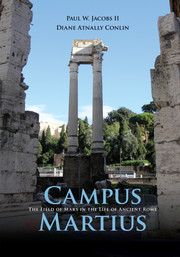Book contents
- Frontmatter
- Contents
- Illustrations
- Acknowledgments
- Maps
- Introduction: “This Place Was Holiest of All”
- Chapter One “The Size of the Plain Is Remarkable”: Defining the Limits of the Campus Martius in Time and Space
- Chapter Two Gathering Troops in the War God's Field
- Chapter Three “Very Costly Temples”: The Campus Martius and Republican Temple Construction
- Chapter Four “Chariot Races,” “Three Theatres,” “An Amphitheatre,” and More: Entertainment in the Campus Martius
- Chapter Five “Colonnades about It in Very Great Numbers”: The Porticoes of the Campus Martius
- Chapter Six Between the Aqua Virgo and the Tiber: Water and the Field of Mars
- Chapter Seven “A Zeal for Buildings”: Reshaping of the Space by the Emperors
- Conclusion: “The Rest of the City a Mere Accessory”
- Appendix A Chronology of Development in the Campus Martius to the Early Fourth Century c.e.
- Appendix B Glossary of Architectural Terms
- Notes
- Selected Bibliography
- Index
- Plate Section
Chapter Two - Gathering Troops in the War God's Field
Published online by Cambridge University Press: 18 December 2014
- Frontmatter
- Contents
- Illustrations
- Acknowledgments
- Maps
- Introduction: “This Place Was Holiest of All”
- Chapter One “The Size of the Plain Is Remarkable”: Defining the Limits of the Campus Martius in Time and Space
- Chapter Two Gathering Troops in the War God's Field
- Chapter Three “Very Costly Temples”: The Campus Martius and Republican Temple Construction
- Chapter Four “Chariot Races,” “Three Theatres,” “An Amphitheatre,” and More: Entertainment in the Campus Martius
- Chapter Five “Colonnades about It in Very Great Numbers”: The Porticoes of the Campus Martius
- Chapter Six Between the Aqua Virgo and the Tiber: Water and the Field of Mars
- Chapter Seven “A Zeal for Buildings”: Reshaping of the Space by the Emperors
- Conclusion: “The Rest of the City a Mere Accessory”
- Appendix A Chronology of Development in the Campus Martius to the Early Fourth Century c.e.
- Appendix B Glossary of Architectural Terms
- Notes
- Selected Bibliography
- Index
- Plate Section
Summary
If you were on the Capitoline facing north on a summer's day in 717 b.c.e., you would have witnessed, according to Plutarch, a large thundercloud drifting ever lower until it touched the swampy ground in the general area where the Pantheon now stands. That ominous mist was about to envelop and carry off Rome's sacred and mythical founder, Romulus. Livy described the fantastical scene occurring on the Nones of Quintilis (July 7), noting that,
as the king was holding a muster in the Campus Martius, near the swamp of Capra [or Goat Marsh], for the purpose of reviewing the army, suddenly a storm came up, with loud claps of thunder, and enveloped him in a cloud so thick as to hide him from the sight of the assembly; and from that moment Romulus was no more on earth.
On seeing Romulus's throne empty, the citizens unanimously recognized that their king had transformed into a deity; they quickly declared Romulus to be a god and the son of a god. This story is revealing in several respects: it suggests a popular recollection of the Campus Martius as a place to muster troops; it notes the early topography of the area as marshy; and, by describing Romulus's ascension, it creates the conditions for a sacred space. As discussed later in this chapter, many centuries after this mythical event, Romans were still making an annual pilgrimage to the Caprae Palus on a holiday called the Nonae Capratinae (Nones of the Goat), possibly to celebrate Romulus's apotheosis.
- Type
- Chapter
- Information
- Campus MartiusThe Field of Mars in the Life of Ancient Rome, pp. 20 - 42Publisher: Cambridge University PressPrint publication year: 2015



